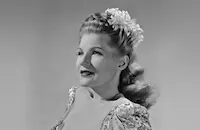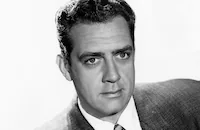The picture began on an extremely upbeat vibe as an attempt to create a solo vehicle for Harpo. This idea, christened as Diamonds in the Pavement, commenced in early 1948 with none other than Ben Hecht at the helm, assisted by gag writer Frank Tashlin. The latter, a former Warner Brothers animation director, was responsible for some of the cartoon unit's most brilliant and hysterical efforts. A major silent screen comedy buff, Tashlin yearned to direct live action, and left his steady employment to pitch gags to comedians like Bob Hope, whom he hoped would later reward him with a chance to show his stuff (as Hope would on the classic Son of Paleface, 1952).
Tashlin first met Harpo during filming of A Night in Casablanca (1946), then announced as the final Marx Brothers picture, where, as a gag man, he contributed the flick's best remembered bit: An indignant, cynical policeman asks a loitering Harpo, leaning against a brick wall, if he thinks he's holding up the building. Harpo grins, maniacally nodding "yes," as the cop pulls him away - causing the entire structure to topple. Harpo and Tashlin hit it off at once, and when Hecht asked Marx if he knew of a good writer to beef up the sight gags, the savvy comic apparently, once again, maniacally nodded "yes."
Tashlin recalls that the writing betwixt the three of them took place at Hecht's Oceanside home and went swimmingly. The trio would work all day, taking breaks for eating, playing horseshoes and enjoying the writer's elaborate electric train system - the size of which Tashlin likened to Long Island City. The movie, basically a study in pantomime, recalled the freewheeling pre-talkie days, and the word-of-mouth was so good that the project had attracted Leo McCarey as a potential director. McCarey, a silent veteran, had guided Laurel & Hardy through many of their earliest and best shorts, including The Battle of the Century (1927), and had seamlessly made the transition to sound, directing such 30s gems as The Awful Truth (1937) and, of course, the Marx Brothers' Duck Soup (1933), generally acknowledged to be the jewel of their Paramount comedies. Tashlin remembers that Rene Clair (Le Million, 1931) had also expressed an interest in the Diamonds script, but before any of these events could come to fruition, the bottom dropped out.
Tashlin, Hecht and Harpo all blame producer Lester Cowan, who had lied about Diamonds' highly touted value to the studio. In fact, United Artists, who had originally agreed to provide backing and distribution, was indeed having second thoughts. Whether Cowan had promised UA the Marx Brothers or not is up to debate, but two concurrent incidents forever crashed Diamonds to the pavement. In 1949, Paramount and MGM re-issued the old Marx Brothers features where they met new critical acclaim, and, more importantly, great box office. Groucho, in the meantime, had scored an enormous success with his new radio series, You Bet Your Life. UA was now adamant: Cowan's show had to have the Marx Brothers.
With their original script (literally) dashed to bits, Hecht removed his name from the picture, now called Love Happy, and Tashlin was paired with Mac Benoff, who was hired to write a framing story and narration for Groucho (who, along with Chico, agreed to appear with their beleaguered brother - at this point desperate to salvage ANYTHING of his once-beloved dream project). Director David Miller, whose background of informational/sports shorts included Drunk Driving (1939) and the unfortunately titled Hurling (1936), provided a springboard to features beginning with the 1941 Technicolor Billy the Kid. According to Tashlin though, he was one of the most unfunny people he had ever met. However, Miller was quite gifted at directing suspense thrillers as he later proved with Sudden Fear (1952) and Midnight Lace (1960).
Of course, surrounding the Marx Brothers with great comic foils like Melville Cooper and Eric Blore, plus a superb cast of villains led by Ilona Massey and Raymond Burr helped the proceedings, as did the presence of a peppy Vera-Ellen in the female lead. But the overall end result, despite a positive review from The New York Times and other major critics, remained a disappointment to Harpo until his dying day. Ironically, in what was at one time to be an experiment in pantomime, it is wise-cracking Groucho, as a low rent private eye, who fares best, particularly in a brief opening scene with a curvaceous client - a soon-to-be-famous starlet, whose appearance in the picture upgraded her to co-star billing with the comedy team when Love Happy was re-released in the mid-1950s!
Groucho recalled the moment this actress was cast during the filming of Love Happy: "The producer called me one day. 'We have three girls here,' he said. 'Why don't you come and pick one out?' I would be picking the girl who would be doing a sexy vignette in the film. Three girls lined up when I arrived. 'Which one do you like?' the producer asked. They walked for us. 'You must be crazy,' I replied. 'There's only one. The blonde.' The girl was signed. For her one scene, she wore a dress cut so low I couldn't the dialogue. Very soon other men throughout the world would be suffering similar fevers, for the girl was Marilyn Monroe."
Producer: Lester Cowan, Mary Pickford
Director: David Miller
Screenplay: Mac Benoff, Frank Tashlin
Production Design: Gabriel Scognamillo
Cinematography: William C. Mellor
Costume Design: Grace Houston, Norma Koch
Film Editing: Al Joseph, Basil Wrangell
Original Music: Ann Ronell
Cast: Groucho Marx (Detective Sam Grunion), Harpo Marx (Harpo), Chico Marx (Faustino the Great), Ilona Massey (Madame Egelichi), Vera-Ellen (Maggie Phillips), Raymond Burr (Alphonse Zoto), Melville Cooper (Lefty Throckmorton), Eric Blore (Mackinaw), Marilyn Monroe (Grunion's client).
BW-85m.
by Mel Neuhaus


























